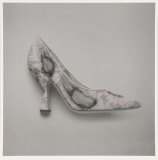Poslední stopa
2018
Doplňky 01-13 ručně kolorované inkoustové tisky na Hahnemühle papíře, 50x50 cm, 2018, edition unique Němý film 01-13 čb ruční zvětšeniny na barytovém papíře, 100x100 nebo 120x50 cm, 2011/2018 edition 3

Expoziční spojení souborů Acessories a Němý film vytváří napětí mezi prehistorií a před-antropocénní krajinou neovlivněnou člověkem, která se z pohledu lidského pokolení nemění, a nedávno luxusními pozůstatky kultury, módními doplňky, které neznámá síla (polární záře?) začíná probarvovat v něco, s čím efemérní lidské počínání nepočítalo. Tyto Acessories, doplňky k lidskému tělu, jsou svým majitelem opuštěny, možná ještě před tím, než se k němu dostaly. Tuto vztahovou situaci s člověkem mají společnou s krajinami souboru Němý film. Jedná se o dva póly "la solitude"- samoty, která je pozitivní, neboť chrání před znetvořením (v případě krajin), a před fetišizací (v případě večerních střevíců, kabelek a klobouků). Expozice Poslední stopa skrývá naději, že vztahy přírody a lidské civilizace se projednou nemusí pokazit. Němá koexistence dvou odlišných pólů vybízí k fenomenálnímu uvažování nad takovou kauzalitou, jakou jsou módní doplňky a graficky stylizované zobrazení krajiny.
(AK)
Tisková zpráva:
Myšlenka jejich společné výstavy putuje českým kulturním vesmírem již nejméně jedno desetiletí. Čas od času se přiblížila na dohled teleskopu některého z předních galerijních ústavů, tamními odborníky ale nikdy nebyla popsána a pojmenována. Konkrétní peripetie jejího neuskutečnění přitom nejsou až tak zajímavé, abychom jim věnovali více pozornosti. Předcházely však paradoxu, kdy se jejich společná výstava, navzdory trvající touze a bezesporné příležitosti, nekoná ani tentokrát.
Jak porozumět znaménku „+“ mezi názvy dvou sousedících, ale přesto samostatných výstav? Je to pouze znak pro společné formální zastřešení jinak nezávislých jednotek? Je to atavismus původního, nerealizovaného záměru? Oba autoři nás přeci v jisté „jednotě směru“ vedou ke spekulaci o posledních dnech lidstva, k vizím zániku civilizace, která nepřichází zvnějšku, ale je důsledkem její inherentní dynamiky. Podobně jako autoři literárních fikcí, filmů či počítačových her s postapo tématikou, lze také u Kotzmannové a Q: klást jejich „vteřiny před“ a „poslední stopy“ do souvislosti ze zhmotňující se hrozbou environmentální katastrofy, se stále zřejmějším faktem, že pro radikální změnu kurzu chybí společenská shoda, politická vůle, nebo prostě jen čas… Za těchto okolností se naděje, toto poslední útočiště, jež člověku umožnilo přestát tolik bezvýchodných situací, obrátí proti svému hostiteli.
Založení dvou paralelních výstav lze však porozumět o něco lépe, když přihlédneme k temperamentu, s níž Kotzmannová a Q: přistoupili k tématu. Alena Kotzmannová zaujímá pozici melancholické pozorovatelky, chodkyně vyprahlou krajinou, v níž nálezy reliktů lidské touhy po kráse a společenském postavení působí stejně jako nálezy neobvykle tvarovaných nerostů. Postava posledního člověka, který se prochází pouští s fotografickým aparátem, zde koneckonců dost dobře může být nahrazena představou automatu, který ještě dlouho po zmizení jeho tvůrců realizuje svůj program a své nálezy mechanicky třídí pro muzeum, které už nikdo nenavštíví. Kotzmannové vztah k aktuální enviromentální krizi je přitom přeci jen volnější. Nikde není psáno, že její fotografie „nepřicházejí“ z tak daleké budoucnosti, kdy vyhynutí lidského rodu nastalo jaksi „samovolně“, únavou materiálu...
Q: zaujímá jiný postoj: myslí na „teď a tady“, ještě „vteřinu před“ buší na poplach, zpochybňuje existenci plánu B, víru v možnost úniku. Monumentálním modelem rakety, která „někam jinam“ odnáší zprávu o lidstvu, ale rovněž dioramatem zobrazujícím zoufalou rodinu astro-osadníků, jsou však paradoxně zamýšleny jako sugestivní smyslové zážitky, jako úchvatné poslední obrazy na kolektivní sítnici lidstva. Jenže snad právě takové má být memento: obrazově silné, aby z paměti vyvstalo vteřinu předtím, než se dystopická skutečnost stane holou přítomností, abychom se naposledy zkusilo rázně strhnout kormidlo v posledním pokusu o záchranu.
Zachování jisté autonomie, kterou autorům umožnilo rozdělení zamýšlené společné výstavy, tak není vyjádřením nějakého osobního (ideologického či vztahového) sporu. Umožňuje však, aby naplno vyzněl rozdíl mezi elegičností (Kotzmannová) a lamentací (Q:), introvertním (Kotzmannová) a extrovertním principem (Q:). A přesto to Kotzmannové nedá a v jeden okamžik vpadne do Q-ovy části, aby alespoň trochu zchladila jeho zápal. A nebo je doplnění „jeho“ výstavy o hasicí přístroje symbolem jakési brzdy, kterou potřebuje spíše civilizace na planetě Zemi?
Jiří Ptáček, tisková zpráva k výstavě Alena Kotzmannová: Poslední stopa& Q: Vteřiny před…
17.10.2018-12.1.2019
kurátor: Jiří Ptáček
Fait Gallery - MEM, Ve Vaňkovce 2, Brno




























